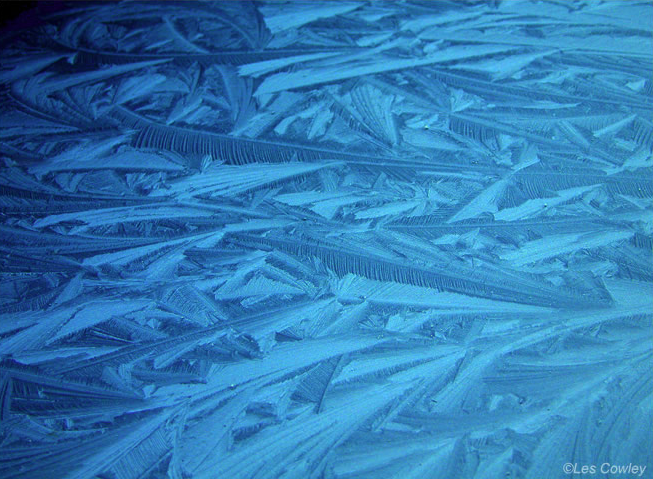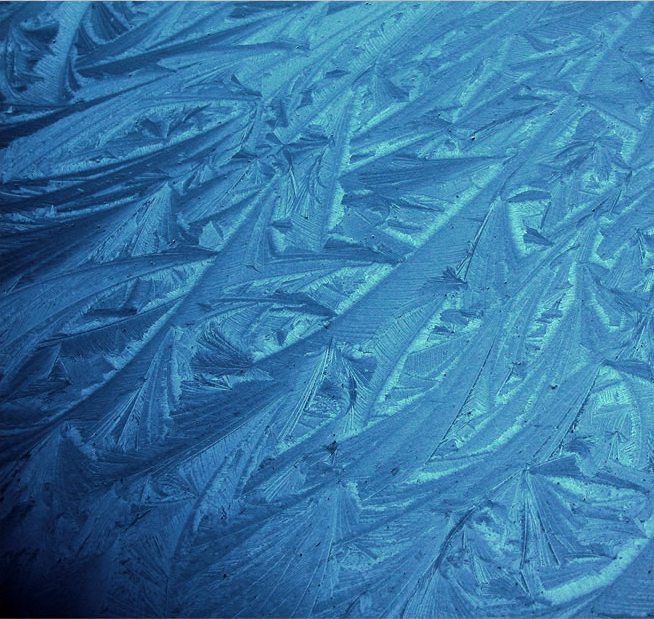Not the Earth from Space
Not the Earth from Space: Exploring Fern Frost
Fern frost, a stunning natural phenomenon, may initially appear like an image of the Earth taken from space. However, it is actually a beautiful formation of ice crystals that can be found on various surfaces after a cold night. In this article, we will delve into the intricate details of fern frost and understand how it is formed.
Frost, in its various forms, grows on the ground and other surfaces based on the fundamental hexagonal structure of ice. The specific type of frost that we refer to as "fern frost" gets its name from the leafy fern-like patterns it creates. It is most commonly observed on window panes and smooth glassy surfaces.
The formation of fern frost begins when the temperature of a surface drops below that of its surroundings. As the surface radiates its heat out to the empty night sky, water molecules from the air condense onto rough nuclei such as scratches, pits, and dust particles. These tiny ice crystals then spread across the cold surface, growing fastest at the edges rather than on the large smooth planes.
The growth of fern frost crystals follows dendritic patterns, resembling delicate tree branches. This intricate structure gives fern frost its characteristic ribbed appearance. Interestingly, snowflakes also exhibit similar complex and symmetrical shapes due to the same crystal growth mechanisms.
The exact reason behind the sweeping gentle curves that form the fern leaf shapes in fern frost is not yet fully understood. However, it is believed to be a general effect rather than a specific phenomenon. It is fascinating to note that the overall shape of fern frost formations can vary depending on factors such as humidity, air temperature, sky conditions, and the texture and conductivity of the surface it forms on.
If you've ever noticed fern frost on your car after a frosty night, you may have observed that the size of the fern shapes tends to be larger on polished and cleaner surfaces. This correlation suggests that the smoothness and cleanliness of a surface may influence the size and intricacy of the fern frost patterns that develop.
In conclusion, fern frost is a captivating natural display that occurs when water vapor in the air condenses and freezes on cold surfaces. The resulting ice crystals grow in intricate dendritic patterns, resembling delicate fern leaves. While the exact mechanisms behind the formation of fern frost shapes are not fully understood, it is clear that factors such as surface texture, temperature, and humidity play a role in creating these stunning patterns.
Next time you come across fern frost on a window pane or a smooth surface, take a moment to appreciate the intricate beauty of nature's ice artistry. It's a reminder of the wonders that can be found even in the smallest and seemingly mundane aspects of our environment.

Not the Earth from Space but fern frost imaged by Martin McKenna (nightskyhunter). �Martin McKenna, shown with permission.


�At 03.00 UT on the morning of 1st December the temp dropped to � 5�C here in Maghera, Northern Ireland making it the most bitter night of the season to date. A severe frost had already coated everything in white not long after sunset the previous evening. However it was during the early morning hours that I spotted this display of 'fern frost' covering the blue roof of the car in a complex array of leaf patterns which was simply gorgeous when illuminated by the near full Moon high in the sky.�
Frost grows on the ground and other surfaces in all manner of forms but all are based on the fundamental hexagonal structure of ice. The particular form taken depend on many thins, the humidity, air temperature, whether the sky is clear and on the texture and conductivity of the surface.
Fern frost, so named for its leafy fern like swathes, is best seen on window panes and other smooth glassy surfaces after a cold night.
Fern frost formation starts when the surface cools below that of the surrounding temperature by radiating its heat out to the empty night sky.
Water molecules from the air condense onto rough (at an atomic level) nuclei � scratches, pits, dust particles. Once a tiny ice crystal has formed it spreads across the cold surface. Crystal growth is fastest at edges rather than on the large smooth planes of facets. We see large single crystal shapes because the initial growth nuclei are far apart. It�s possible that the more polished and cleaner is your car, the larger the fern shapes!
The growth is dendritic, treelike, along the hexagonal crystal directions to give the characteristic ribbed appearance. The complex but overall symmetric shapes of snowflakes are similarly produced.
Why do the crystal intersections have sweeping gentle curves to give the fern leaf shapes? I don�t know. But whatever controls the overall shapes is a general effect, at right are more fern shapes pictured on my own car after a frosty night a few years ago.
Note: this article has been automatically converted from the old site and may not appear as intended. You can find the original article here.
Reference Atmospheric Optics
If you use any of the definitions, information, or data presented on Atmospheric Optics, please copy the link or reference below to properly credit us as the reference source. Thank you!
-
<a href="https://atoptics.co.uk/blog/not-the-earth-from-space/">Not the Earth from Space</a>
-
"Not the Earth from Space". Atmospheric Optics. Accessed on November 25, 2024. https://atoptics.co.uk/blog/not-the-earth-from-space/.
-
"Not the Earth from Space". Atmospheric Optics, https://atoptics.co.uk/blog/not-the-earth-from-space/. Accessed 25 November, 2024
-
Not the Earth from Space. Atmospheric Optics. Retrieved from https://atoptics.co.uk/blog/not-the-earth-from-space/.